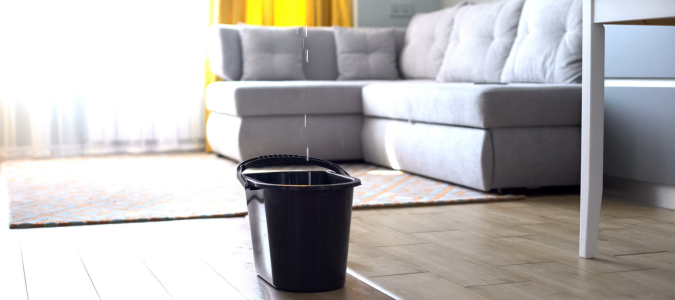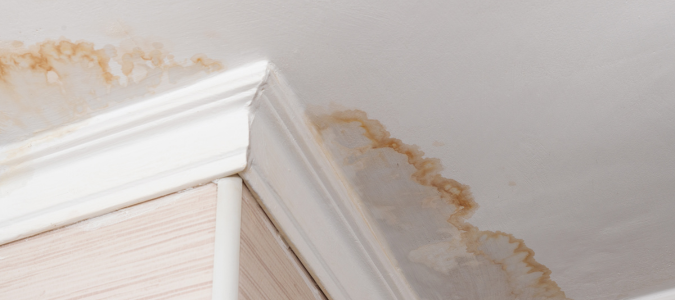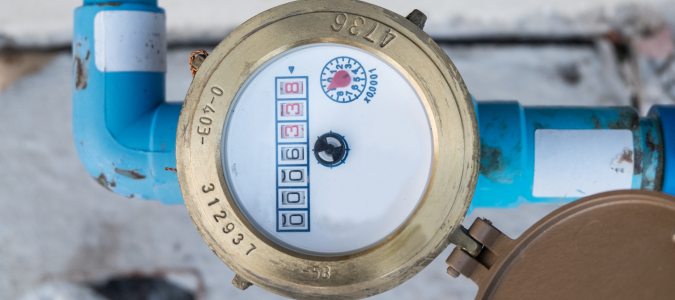A ceiling leak is a problem that no homeowner should ignore. If you see water dripping, brown stains forming or paint bubbling, these are signs of a ceiling leak, and you should address it as soon as you can.
Here’s everything you need to know about the issue, including the causes of leaks and what you should do. Contact a professional plumber to get to the root of the problem and find a solution before the damage gets worse.
There are two common reasons why water is leaking from the ceiling. It can be a plumbing issue, such as a leaking shower or damaged piping. Or, there is an issue with your roof, causing water to come in. Here’s how these problems can lead to a ceiling leak.
Damaged Pipes
Burst pipes are one of the most common causes of ceiling leaks in the winter. When temperatures get extremely low, the water inside the pipes cools down fast and expands. That puts a lot of pressure on the pipes and can cause them to burst. A professional plumber can give you tips on how to keep pipes from freezing without heat.
Damaged pipes can lead to flooding and damage the ceiling. The water lines most prone to bursting in the winter are those located upstairs that lead to the bathroom and laundry room. You’ll know it is water from burst pipes because it is light in color or nearly clear.
Roof Leak
Damaged shingles, poor attic ventilation and openings like vents and chimneys can cause roof leaks. A leaking roof allows the outside elements to enter your home, leading to trapped moisture inside the attic and a soaked ceiling below. Roof damage can happen any time of the year. A telling sign that it is a roof leak is if the water is brown or dirty.
Faulty Appliances
This issue will only apply to you if you have appliances on the second floor of your home. That includes dishwashers, refrigerators and washing machines. These appliances have drain and supply lines that can get damaged and flood the second floor. That can explain why water is leaking from the ceiling. The water can also seep into the wall behind the appliance before flowing downwards. Similar to damaged piping, ceiling leaks from faulty appliances will likely have clear water.
If you can’t locate the cause of the ceiling leak, have a licensed plumber assess the situation. The professional has the tools and expertise to diagnose the problem and will provide an immediate solution.
What to Do When You Have a Ceiling Leak
Ceiling leaks usually start small. If the leak in your home isn’t severe and there’s no risk of ceiling collapse, here are some things you can do to begin addressing it.
Catch the Dripping Water
The first step is to get furniture, decor and other valuables out of the way to keep them dry. If something is too heavy to move, cover it with a waterproof material like a plastic sheet or tarp. You should also mop the water to prevent the floor from warping or developing mold. Next, place a gallon bucket or a large container underneath the leak to catch the dripping water. Empty the bucket or container regularly to keep it from overflowing.
Manage the Water Flow
If a plumbing issue is causing the ceiling leak, restrict the water use in that area of the house until you’ve resolved the problem. But, if you don’t know what causes the leak and there’s significant water flow, shut off the main water line and turn on a faucet on the first floor. That will allow the water to drain from the pipeline and give you time to address the leak.
If roof damage is causing the ceiling leak, it will be harder to manage water flow. There’s not much you can do about the weather outside.
Fix the Leak Source
If the leak is small and it is accessible to you, you can try to fix it yourself. Simple repairs like reapplying the caulk around the bathtub or cleaning the gutters shouldn’t be a problem. But if it’s a larger problem and the leak persists, it is time to contact the professionals. Some repairs are too complex for homeowners, such as fixing broken pipes or severe roof damage. Contact a professional that can help you with leak detection and repair.
What to Do When There Are Water Spots on Ceiling But No Leak
Water spots on the ceiling aren’t pretty to look at. But aside from being unsightly, they are a sign of an underlying problem. It means water is leaking somewhere in your home, even if you don’t see it.
Ice dams on the roof can trap water and cause a leak, explaining the water spots. Condensation is another possible culprit behind the stains. It occurs when excess frost develops in the attic during the winter. As the weather warms up, the ice will melt and leave behind water spots on random parts of the ceiling.
Covering up water stains without addressing the leak will only lead to a more severe and expensive problem. That is why it is wise to get the help of a licensed plumber who will know how to find the water leak’s source and can get to work fixing it. Once they have addressed the root of the issue, you can do the following steps to restore the beauty of your ceiling.
Use Bleach to Remove the Stains
Mix a cup of bleach with three cups of water to create a mild solvent. It can help lighten the water spots on your ceiling and clean dirt, dust and mildew simultaneously. Saturate a sponge with the bleach solution and rub it on the affected areas. Wipe with a clean cloth after. Wear gloves and goggles to protect yourself from the bleach.
Apply Stain-Blocking Primer
It can be tempting to hide the water spots with paint and call it a day. But indoor latex paint won’t solve the problem. It’s water-soluble, so the stain will still show through. If you want the best results, use an oil-based primer that resists molds and blocks stains. Unlike latex paint, these primers contain a lot of binders, helping them adhere well to surfaces. Choose one in a shade that’s close to your ceiling’s color.
Paint Over the Primer
The area with primer will usually look darker than everything else. You can paint over the primer to even things out. It’s best to use paint specifically for ceilings, as they’re thicker and have a non-reflective finish that helps to conceal blemishes.
How to Read a Water Meter for Leaks
If you think there is a leak somewhere in your home, you can use a water meter to confirm your suspicions. The first step is to turn off all devices that use water. That includes faucets, toilets, washing machines and sprinkler systems. Next, locate the water meter. Indoor meters can be in the garage, basement or utility room, while outdoor meters are usually in an underground meter box. Once you’ve found it, open the lid to see the register face.
Almost every meter has a leak indicator. A small dial moves every time water flows in the house. If all the water-using devices in your home are off, but the leak indicator is moving, there is a leak. But if it is still, you don’t have a problem and can relax. Another method is to check the meter, take note of the reading and check again an hour later. There might be a leak if the number changes. If that’s the case, turn off the water supply and contact a licensed plumber.
When to Seek Professional Help
Ceiling leaks can be hard to detect. It can be even harder to determine the cause of the leak and repair whatever’s broken. Professional plumbers can help you get to the root of the problem. They will assess the situation and provide the appropriate solution.
ABC Can Help With Ceiling Leaks
When you suspect you may have a plumbing problem, don’t wait to call a professional. In mere minutes, a water leak can cause thousands of dollars in damage, sometimes making your home unlivable. When you have a plumbing problem, like a water leak, count on the licensed, experienced professionals at ABC Home & Commercial Services to take care of the issue so that you can get back to enjoying your home. They can also help with other plumbing needs, like learning the benefits of a water softener.



